System control MITSUBISHI ECLIPSE CROSS 2019 (in English) Manual Online
[x] Cancel search | Manufacturer: MITSUBISHI, Model Year: 2019, Model line: ECLIPSE CROSS, Model: MITSUBISHI ECLIPSE CROSS 2019Pages: 423, PDF Size: 75.41 MB
Page 164 of 423
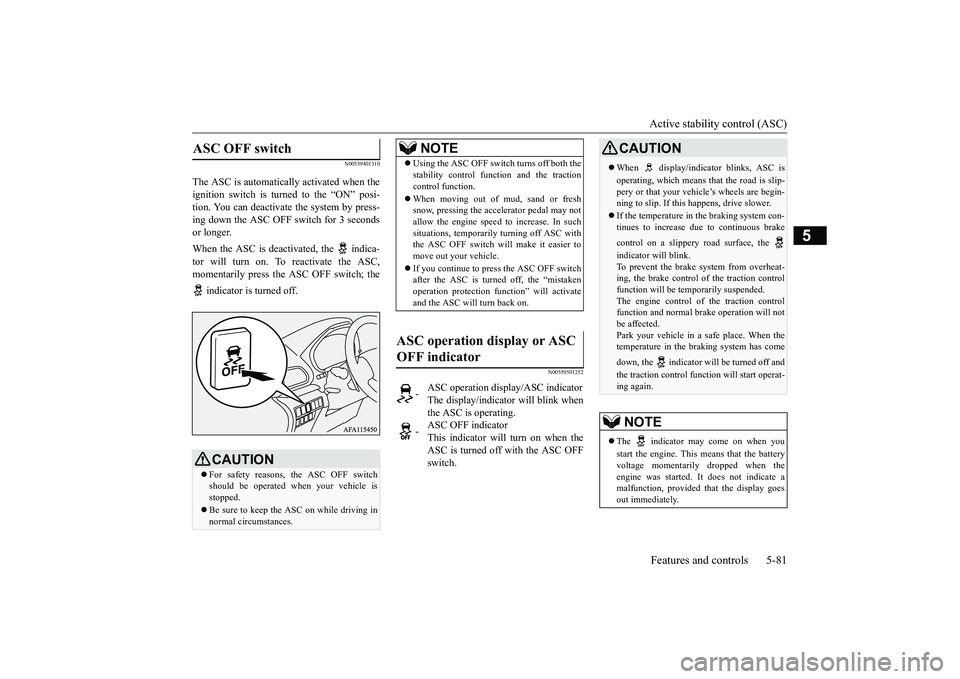
Active stability control (ASC) Features and controls 5-81
5
N00559401310
The ASC is automatically activated when the ignition switch is turned to the “ON” posi- tion. You can deactivate the system by press- ing down the ASC OFF switch for 3 secondsor longer. When the ASC is deactivated, the indica- tor will turn on. To reactivate the ASC, momentarily press the ASC OFF switch; the indicator is turned off.
N00559501252
ASC OFF switch
CAUTION For safety reasons, the ASC OFF switch should be operated when your vehicle isstopped. Be sure to keep the ASC on while driving in normal circumstances.
NOTE
Using the ASC OFF switch turns off both the stability control function and the traction control function. When moving out of mud, sand or fresh snow, pressing the accelerator pedal may not allow the engine speed to increase. In such situations, temporarily turning off ASC withthe ASC OFF switch will make it easier to move out your vehicle. If you continue to press the ASC OFF switch after the ASC is turned off, the “mistaken operation protection function” will activateand the ASC will turn back on.
ASC operation display or ASC OFF indicator
-
ASC operation display/ASC indicator The display/indicator will blink whenthe ASC is operating.
-
ASC OFF indicator This indicator will turn on when theASC is turned off with the ASC OFF switch.
CAUTION When display/indicator blinks, ASC is operating, which means that the road is slip- pery or that your vehicle’s wheels are begin- ning to slip. If this happens, drive slower. If the temperature in the braking system con- tinues to increase due to continuous brake control on a slippery road surface, the indicator will blink. To prevent the brake system from overheat- ing, the brake control of the traction controlfunction will be temporarily suspended. The engine control of the traction control function and normal brake operation will notbe affected. Park your vehicle in a safe place. When the temperature in the braking system has come down, the indicator will be turned off and the traction control f
unction will start operat-
ing again.NOTE
The indicator may come on when you start the engine. This means that the battery voltage momentarily dropped when the engine was started. It does not indicate a malfunction, provided that the display goesout immediately.
BK0266800US.bo
ok 81 ページ 2018年6月27日 水曜日 午後5時6分
Page 165 of 423
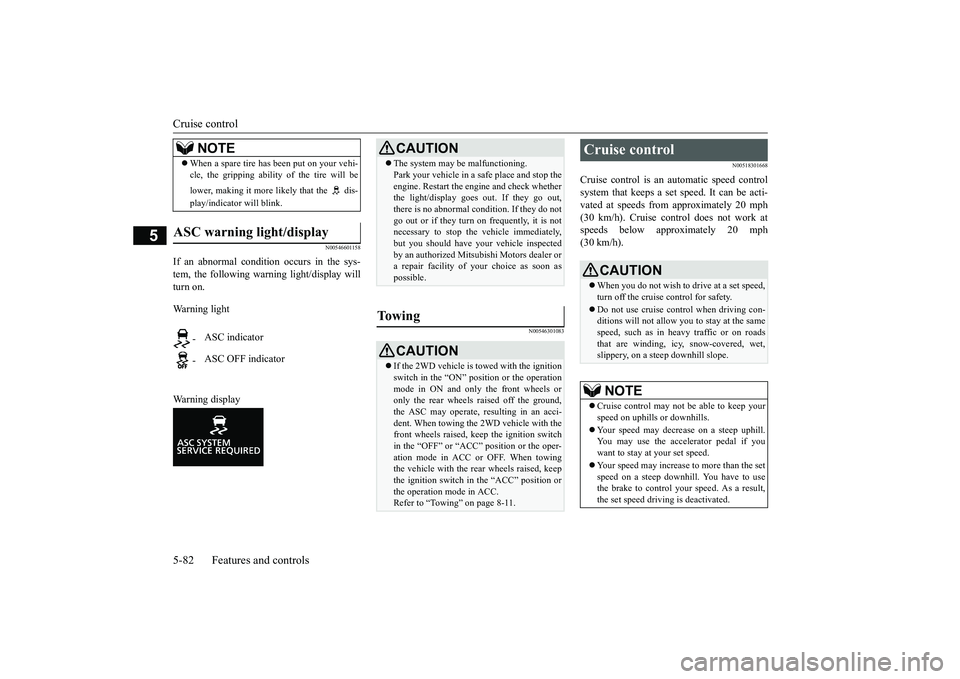
Cruise control 5-82 Features and controls
5
N00546601158
If an abnormal condition occurs in the sys- tem, the following warning light/display willturn on. Warning light Warning display
N00546301083
N00518301668
Cruise control is an automatic speed control system that keeps a set speed. It can be acti-vated at speeds from approximately 20 mph (30 km/h). Cruise control does not work at speeds below approximately 20 mph(30 km/h).
When a spare tire has been put on your vehi- cle, the gripping abilit
y of the tire will be
lower, making it more likely that the dis- play/indicator will blink.
ASC warning light/display
-
ASC indicator
-
ASC OFF indicatorNOTE
CAUTION The system may be malfunctioning. Park your vehicle in a safe place and stop the engine. Restart the engine and check whether the light/display goes out. If they go out, there is no abnormal condition. If they do notgo out or if they turn on frequently, it is not necessary to stop the vehicle immediately, but you should have your vehicle inspectedby an authorized Mitsubishi Motors dealer or a repair facility of
your choice as soon as
possible.
To w i n g
CAUTION If the 2WD vehicle is towed with the ignition switch in the “ON” position or the operation mode in ON and only the front wheels oronly the rear wheels raised off the ground, the ASC may operate, resulting in an acci- dent. When towing the 2WD vehicle with thefront wheels raised, keep the ignition switch in the “OFF” or “ACC” position or the oper- ation mode in ACC or OFF. When towing the vehicle with the rear wheels raised, keep the ignition switch in the “ACC” position orthe operation mode in ACC. Refer to “Towing” on page 8-11.
Cruise control
CAUTION When you do not wish to drive at a set speed, turn off the cruise control for safety. Do not use cruise control when driving con- ditions will not allow you to stay at the same speed, such as in heavy traffic or on roadsthat are winding, icy, snow-covered, wet, slippery, on a steep downhill slope.NOTE
Cruise control may not be able to keep your speed on uphills or downhills. Your speed may decrease on a steep uphill. You may use the accelerator pedal if you want to stay at your set speed. Your speed may increase to more than the set speed on a steep downhill. You have to usethe brake to control your speed. As a result, the set speed driving is deactivated.
BK0266800US.bo
ok 82 ページ 2018年6月27日 水曜日 午後5時6分
Page 169 of 423

Cruise control 5-86 Features and controls
5
The set speed driving is deactivated automati- cally in any of the following ways. When your speed slows to approximately 10 mph (15 km/h) or more below the set speed because of a hill, etc. When your speed slows to approximately 20 mph (30 km/h) or less. When the active stability control (ASC) starts operating. Refer to “Active stability control (ASC)” on page 5-79.
Also, the set speed driving may be deacti- vated as follow: When the engine speed rises and approaches the tachometer’s red zone (the red-colored part of the tachometer dial).
N00518901420
If the set speed driving is deactivated by thecondition described in “To deactivate” onpage 5-85, you can resume the previously set speed by push up the “RES +” switch while driving at a speed of approximately 20 mph(30 km/h) or higher. The “SET” indicator appears on the informa- tion screen of the multi-information display.
Under either of the following conditions, however, using the switch does not allow you to resume the previously set speed. In thesesituations, repeat the speed setting procedure: The CRUISE CONTROL ON/OFF switch is pressed. The ignition switch is turned to the “OFF” position or the operation mode is put in OFF. Indicator go off.
WA R N I N GAlthough the set speed driving will be deactivated when shifting to the “N”(NEUTRAL) position, never move the selector lever to the “N” (NEUTRAL) position while driving.You would have no engine braking and could cause a serious accident.
CAUTION When the set speed driving is deactivated automatically in any situation other than those listed above, there may be a system malfunction. Press the CRUISE CONTROL ON/OFFswitch to turn off the cruise control and have your vehicle inspected by an authorized Mitsubishi Motors dealer or a repair facilityof your choice.
To resume the set speed
BK0266800US.bo
ok 86 ページ 2018年6月27日 水曜日 午後5時6分
Page 170 of 423
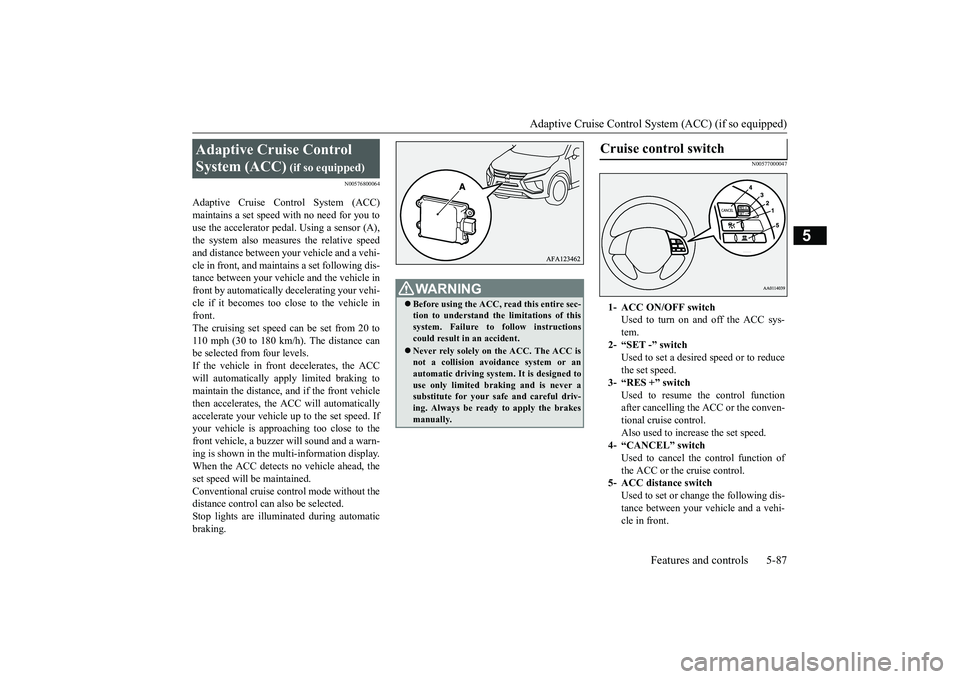
Adaptive Cruise Control System (ACC) (if so equipped)
Features and controls 5-87
5
N00576800064
Adaptive Cruise Control System (ACC) maintains a set speed with no need for you to use the accelerator pedal. Using a sensor (A), the system also measures the relative speedand distance between your vehicle and a vehi- cle in front, and maintains a set following dis- tance between your vehicle and the vehicle infront by automatically decelerating your vehi-cle if it becomes too close to the vehicle in front. The cruising set speed can be set from 20 to110 mph (30 to 180 km/h). The distance can be selected from four levels. If the vehicle in front decelerates, the ACCwill automatically apply limited braking to maintain the distance, and if the front vehicle then accelerates, the ACC will automaticallyaccelerate your vehicle up to the set speed. If your vehicle is approaching too close to the front vehicle, a buzzer will sound and a warn-ing is shown in the multi-information display. When the ACC detects no vehicle ahead, the set speed will be maintained.Conventional cruise control mode without the distance control can also be selected. Stop lights are illuminated during automaticbraking.
N00577000047
Adaptive Cruise Control System (ACC)
(if so equipped)
WA R N I N G Before using the ACC, read this entire sec- tion to understand the limitations of this system. Failure to follow instructions could result in an accident. Never rely solely on the ACC. The ACC is not a collision avoidance system or anautomatic driving system. It is designed to use only limited braking and is never a substitute for your safe and careful driv-ing. Always be ready to apply the brakes manually.
Cruise control switch
1- ACC ON/OFF switch
Used to turn on and off the ACC sys- tem.
2- “SET -” switch
Used to set a desired speed or to reduce the set speed.
3- “RES +” switch
Used to resume the control function after cancelling the ACC or the conven- tional cruise control.Also used to increase the set speed.
4- “CANCEL” switch
Used to cancel the control function ofthe ACC or the cruise control.
5- ACC distance switch
Used to set or change the following dis-tance between your vehicle and a vehi- cle in front.
BK0266800US.bo
ok 87 ページ 2018年6月27日 水曜日 午後5時6分
Page 171 of 423
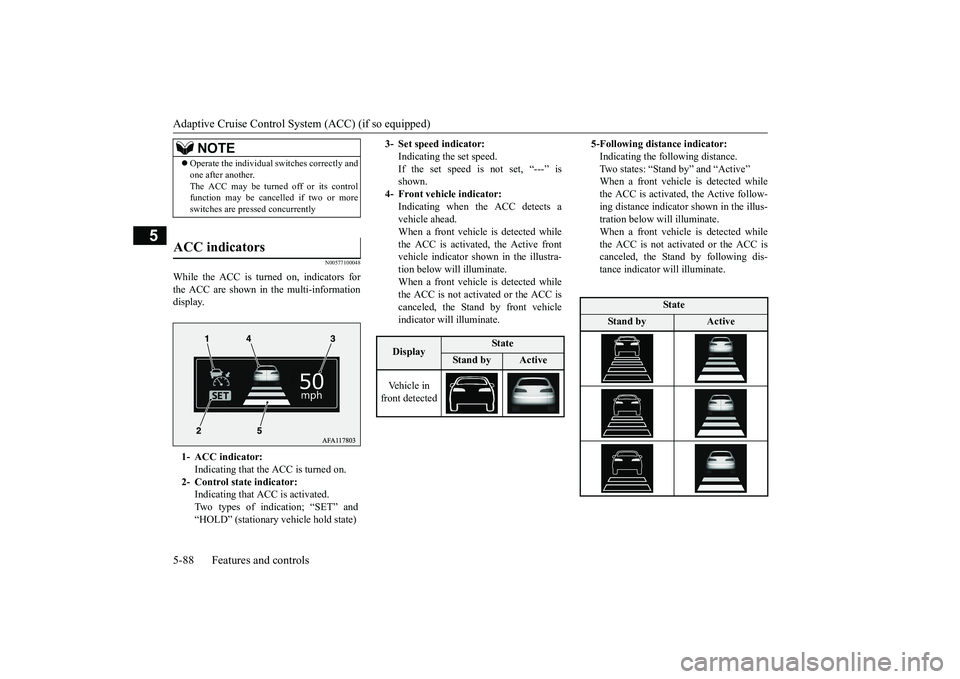
Adaptive Cruise Control System (ACC) (if so equipped) 5-88 Features and controls
5
N00577100048
While the ACC is turned on, indicators for the ACC are shown in the multi-information display.
NOTE
Operate the individual switches correctly and one after another. The ACC may be turned off or its control function may be cancelled if two or more switches are pressed concurrently
ACC indicators
1- ACC indicator:
Indicating that the ACC is turned on.
2- Control state indicator:
Indicating that ACC is activated. Two types of indication; “SET” and“HOLD” (stationary vehicle hold state)
3- Set speed indicator:
Indicating the set speed. If the set speed is not set, “---” is shown.
4- Front vehicle indicator:
Indicating when the ACC detects a vehicle ahead. When a front vehicle is detected whilethe ACC is activated, the Active front vehicle indicator shown in the illustra- tion below will illuminate.When a front vehicle is detected whilethe ACC is not activated or the ACC is canceled, the Stand by front vehicle indicator will illuminate.Display
State
Stand by
Active
Vehicle in front detected
5-Following distance indicator: Indicating the following distance.Two states: “Stand by” and “Active” When a front vehicle is detected while the ACC is activated, the Active follow-ing distance indicator shown in the illus- tration below will illuminate. When a front vehicle is detected whilethe ACC is not activated or the ACC is canceled, the Stand by following dis- tance indicator will illuminate.
State
Stand by
Active
BK0266800US.bo
ok 88 ページ 2018年6月27日 水曜日 午後5時6分
Page 172 of 423

Adaptive Cruise Control System (ACC) (if so equipped)
Features and controls 5-89
5
N00577200081
When the ignition switch is in the “ON” posi- tion or the operation mode in ON, press theACC ON/OFF switch.
The ACC indicators will appear in the multi- information display. Press the ACC ON/OFF switch to turn off the ACC.
With the ACC turned on, push down the “SET -” switch while driving, and when your vehicle reaches your desired speed, releasethe “SET -” switch. The ACC will activateand initiate the speed control to maintain the set speed. The set indicator comes on, the set speed is indicated and the following distance indicatorchanges to the active display.
How to use ACC
To turn on ACC
State
Stand by
Active
NOTE
Every time the ignition switch is in the “OFF” position or the operation mode inOFF, the ACC is turned off.
To turn off ACC
NOTE
The ACC can be turned off even while the ACC is active.
Every time the operation mode is turned off, the ACC is turned off and the set speed is erased.
To activate ACC control
NOTE
BK0266800US.bo
ok 89 ページ 2018年6月27日 水曜日 午後5時6分
Page 173 of 423
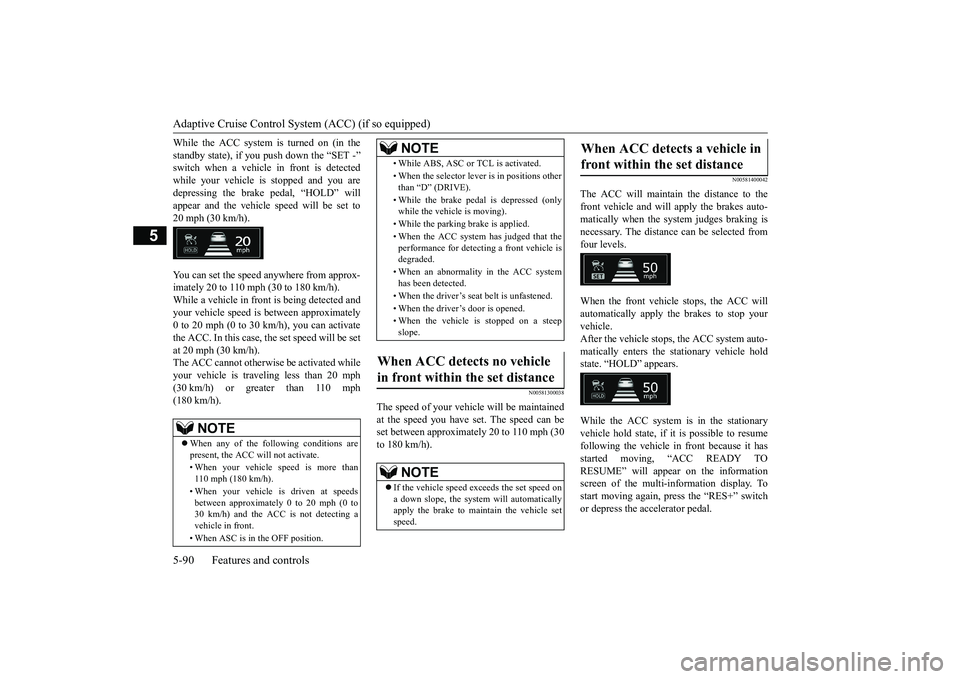
Adaptive Cruise Control System (ACC) (if so equipped) 5-90 Features and controls
5
While the ACC system is turned on (in the standby state), if you push down the “SET -” switch when a vehicle in front is detected while your vehicle is stopped and you aredepressing the brake pedal, “HOLD” will appear and the vehicle speed will be set to 20 mph (30 km/h). You can set the speed anywhere from approx- imately 20 to 110 mph (30 to 180 km/h). While a vehicle in front is being detected and your vehicle speed is between approximately0 to 20 mph (0 to 30 km/h), you can activatethe ACC. In this case, the set speed will be set at 20 mph (30 km/h). The ACC cannot otherwise be activated whileyour vehicle is traveling less than 20 mph (30 km/h) or greater than 110 mph (180 km/h).
N00581300038
The speed of your vehicle will be maintainedat the speed you have set. The speed can be set between approximately 20 to 110 mph (30 to 180 km/h).
N00581400042
The ACC will maintain the distance to thefront vehicle and will apply the brakes auto- matically when the system judges braking is necessary. The distance can be selected fromfour levels. When the front vehicle stops, the ACC will automatically apply the brakes to stop yourvehicle. After the vehicle stops, the ACC system auto- matically enters the stationary vehicle holdstate. “HOLD” appears. While the ACC system is in the stationary vehicle hold state, if it is possible to resume following the vehicle in front because it has started moving, “ACC READY TORESUME” will appear on the information screen of the multi-information display. To start moving again, press the “RES+” switchor depress the accelerator pedal.
NOTE
When any of the following conditions are present, the ACC will not activate. • When your vehicle speed is more than 110 mph (180 km/h). • When your vehicle is driven at speeds between approximately 0 to 20 mph (0 to30 km/h) and the ACC is not detecting a vehicle in front. • When ASC is in the OFF position.
• While ABS, ASC or TCL is activated. • When the selector lever is in positions other than “D” (DRIVE). • While the brake pedal is depressed (only while the vehicle is moving). • While the parking brake is applied. • When the ACC system has judged that the performance for detecting a front vehicle is degraded. • When an abnormality in the ACC system has been detected. • When the driver’s seat belt is unfastened. • When the driver’s door is opened.• When the vehicle is stopped on a steep slope.
When ACC detects no vehicle in front within the set distance
NOTE
If the vehicle speed exceeds the set speed on a down slope, the system will automaticallyapply the brake to maintain the vehicle set speed.NOTE
When ACC detects a vehicle in front within the set distance
BK0266800US.bo
ok 90 ページ 2018年6月27日 水曜日 午後5時6分
Page 174 of 423

Adaptive Cruise Control System (ACC) (if so equipped)
Features and controls 5-91
5
When the ACC no longer detects a vehicle in front, the buzzer will sound, the vehicle sym- bol in the display will disappear and your vehicle will slowly accelerate to the setspeed.
N00576900052
While the ACC is activat
ed, if your vehicle is
approaching too closely to the vehicle infront, the ACC gives a warning by sounding a buzzer and displaying a message. Apply the brakes to maintain the appropriate distance tothe vehicle in front.
WA R N I N G Never leave your vehicle while the ACC system is in the stationary vehicle hold state. When leaving the vehicle, apply the parking brake and move the selector leverto the “P” (PARK) position.NOTE
When the ACC system is in the stationary vehicle hold state, the stop lights will illumi-nate. While the ACC system is in the stationary vehicle hold state, the vehicle will not start moving again unless you press the “RES+” switch or depress the accelerator pedal. When depressing the brake pedal while the automatic brake is applied, the brake pedalwill feel firm. This is normal. Depress the brake pedal harder to apply greater braking force. During the automatic braking, operation sounds may be heard. This is normal. If the turn-signal lever is operated while the ACC is active, the system may accelerate the vehicle to assist you in passing a vehicle in front.
If the vehicle in front starts moving within 2 seconds after stopping, your vehicle will start moving.WA R N I N G Your vehicle may accelerate up to the set speed in the following situations. Apply the brake, if necessary, to slow down.• When your vehicle no longer follows thevehicle in front, e.g. at a freeway exit or when your vehicle or the vehicle in frontchanges its lane.NOTE
• When driving on a curve. When the vehicle in front has changed its course or lane, if a stationary vehicle appears in front your vehicle, the ACC will not decelerate your vehicle.
Approach alarm
WA R N I N G
BK0266800US.bo
ok 91 ページ 2018年6月27日 水曜日 午後5時6分
Page 175 of 423
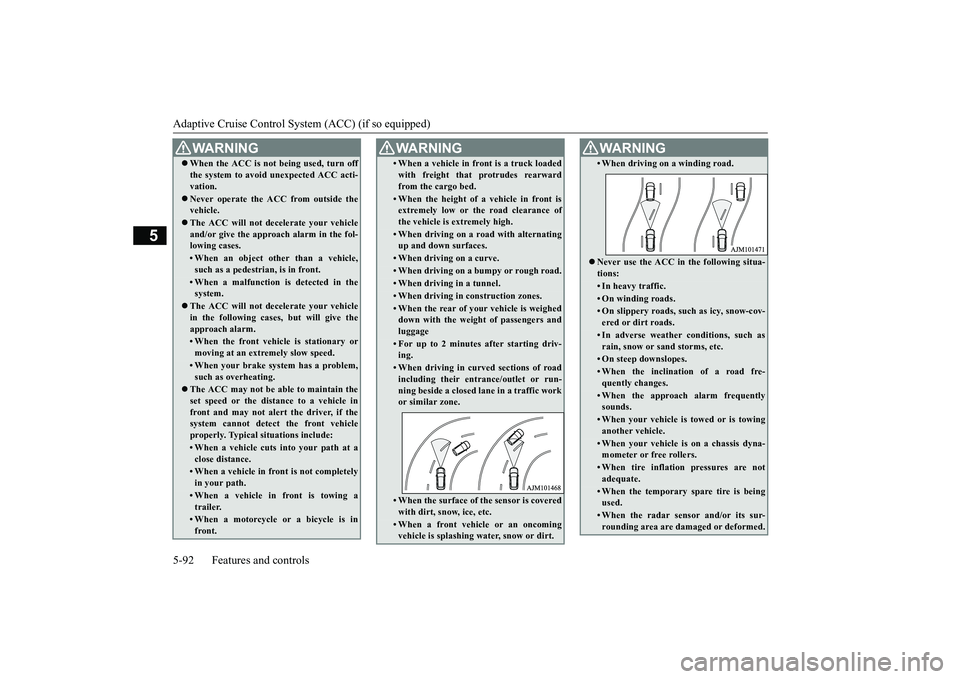
Adaptive Cruise Control System (ACC) (if so equipped) 5-92 Features and controls
5
WA R N I N G When the ACC is not being used, turn off the system to avoid unexpected ACC acti- vation. Never operate the ACC from outside the vehicle. The ACC will not decelerate your vehicle and/or give the approach alarm in the fol- lowing cases.• When an object other than a vehicle,such as a pedestrian, is in front. • When a malfunction is detected in thesystem.
The ACC will not decelerate your vehicle in the following cases, but will give the approach alarm.• When the front vehicle is stationary ormoving at an extremely slow speed.• When your brake system has a problem,such as overheating.
The ACC may not be able to maintain the set speed or the distance to a vehicle infront and may not alert the driver, if the system cannot detect the front vehicle properly. Typical situations include: • When a vehicle cuts into your path at aclose distance.• When a vehicle in front is not completelyin your path.• When a vehicle in front is towing atrailer.• When a motorcycle or a bicycle is infront.
• When a vehicle in front is a truck loaded with freight that protrudes rearward from the cargo bed.• When the height of a vehicle in front isextremely low or the road clearance of the vehicle is extremely high.• When driving on a road with alternatingup and down surfaces.• When driving on a curve.• When driving on a bumpy or rough road.• When driving in a tunnel.• When driving in construction zones.• When the rear of your vehicle is weighed down with the weight of passengers and luggage• For up to 2 minutes after starting driv-ing.• When driving in curved sections of roadincluding their entrance/outlet or run- ning beside a closed lane in a traffic workor similar zone.• When the surface of the sensor is coveredwith dirt, snow, ice, etc.• When a front vehicle or an oncomingvehicle is splashing water, snow or dirt. WA R N I N G
• When driving on a winding road. Never use the ACC in the following situa- tions:• In heavy traffic.• On winding roads.• On slippery roads, such as icy, snow-cov- ered or dirt roads.• In adverse weather conditions, such asrain, snow or sand storms, etc.• On steep downslopes.• When the inclination of a road fre- quently changes.• When the approach alarm frequentlysounds.• When your vehicle is towed or is towinganother vehicle.• When your vehicle is on a chassis dyna-mometer or free rollers.• When tire inflation pressures are notadequate.• When the temporary spare tire is beingused.• When the radar sensor and/or its sur-rounding area are damaged or deformed.WA R N I N G
BK0266800US.bo
ok 92 ページ 2018年6月27日 水曜日 午後5時6分
Page 176 of 423
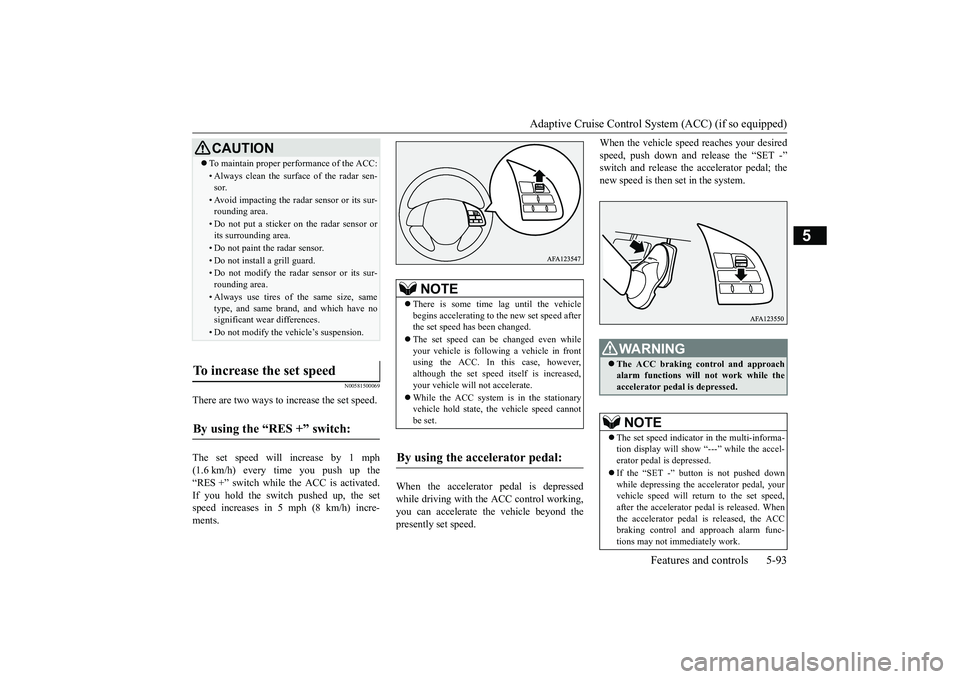
Adaptive Cruise Control System (ACC) (if so equipped)
Features and controls 5-93
5
N00581500069
There are two ways to increase the set speed. The set speed will increase by 1 mph (1.6 km/h) every time you push up the“RES +” switch while the ACC is activated. If you hold the switch pushed up, the set speed increases in 5 mph (8 km/h) incre-ments.
When the accelerator pedal is depressed while driving with the ACC control working,you can accelerate the vehicle beyond the presently set speed.
When the vehicle speed reaches your desired speed, push down and release the “SET -” switch and release the accelerator pedal; the new speed is then set in the system.
CAUTION To maintain proper performance of the ACC:• Always clean the surface of the radar sen- sor.• Avoid impacting the radar sensor or its sur-rounding area.• Do not put a sticker on the radar sensor orits surrounding area.• Do not paint the radar sensor.• Do not install a grill guard.• Do not modify the radar sensor or its sur- rounding area.• Always use tires of the same size, sametype, and same brand, and which have nosignificant wear differences.• Do not modify the vehicle’s suspension.
To increase the set speed
By using the “RES +” switch:
NOTE
There is some time lag until the vehicle begins accelerating to the new set speed after the set speed has been changed. The set speed can be changed even while your vehicle is following a vehicle in frontusing the ACC. In this case, however, although the set speed itself is increased, your vehicle will not accelerate. While the ACC system is in the stationary vehicle hold state, the vehicle speed cannotbe set.
By using the accelerator pedal:
WA R N I N G The ACC braking control and approach alarm functions will not work while the accelerator pedal is depressed.NOTE
The set speed indicator in the multi-informa- tion display will show “---” while the accel- erator pedal is depressed. If the “SET -” button is not pushed down while depressing the accelerator pedal, yourvehicle speed will return to the set speed, after the accelerator pedal is released. When the accelerator pedal is released, the ACCbraking control and approach alarm func- tions may not immediately work.
BK0266800US.bo
ok 93 ページ 2018年6月27日 水曜日 午後5時6分